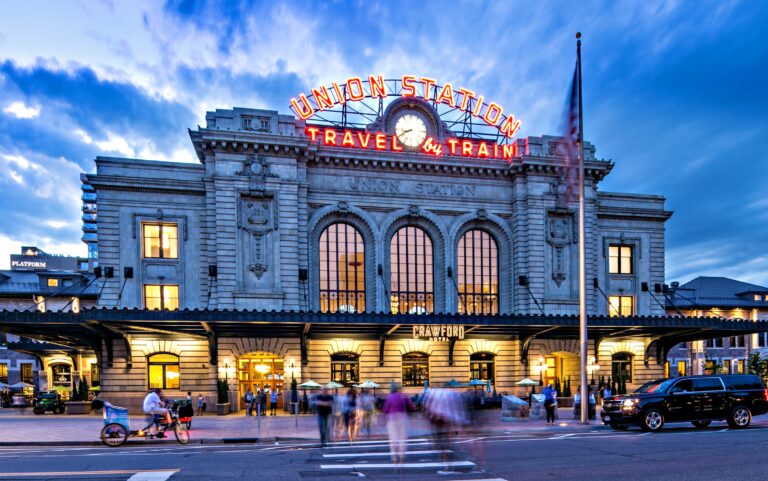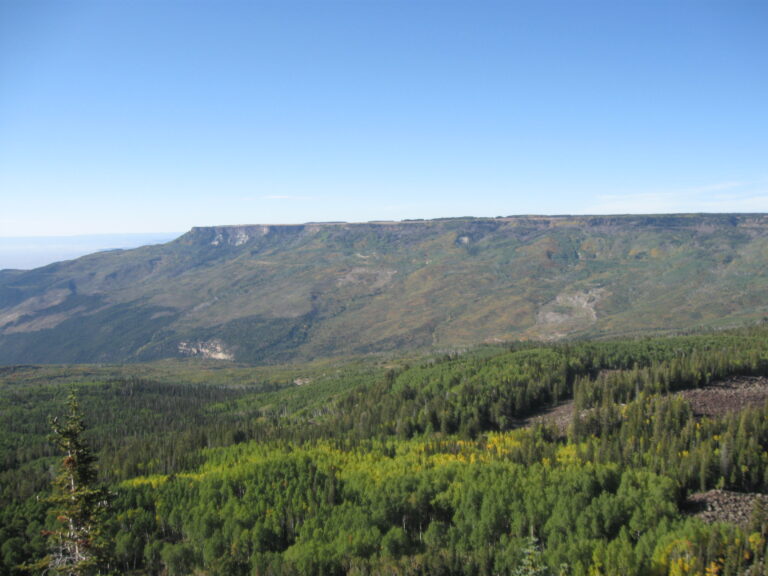 Its breathtaking setting certainly deserves the title, but Estes Park is not really a park ? At least not in the typical sense of the word. In geologic lingo, “park” describes a glacially cut, level valley between mountain ranges. And this is exactly where this picturesque hamlet is located.
Its breathtaking setting certainly deserves the title, but Estes Park is not really a park ? At least not in the typical sense of the word. In geologic lingo, “park” describes a glacially cut, level valley between mountain ranges. And this is exactly where this picturesque hamlet is located.
Estes Park, Colorado, is nestled in a high alpine valley on the eastern slopes of the Rocky Mountains, near 7,500 feet elevation. Bald eagles soar in the usually blue skies above, and great herds of elk and bighorn sheep migrate across the region. In fact, the big animals often graze in and around town, much to the chagrin of local gardeners.
Surrounded by magnificent snow-capped peaks, this pristine glacial valley has been a vacation spot for generations. Unlike other Colorado mountain communities, however, Estes Park did not start out as a mining town. It was a favorite summer hunting ground for native Ute and Arapaho Indians when Kentuckian Joel Estes “discovered” this magnificent spot in mid-October 1859.
By the next summer, Estes had decided to make a living hunting, fishing and raising cattle in the area bearing his name today. Occasionally he would host early travelers who came to explore the rugged beauty of granite summits towering over forested valleys, twisted rivers and glistening lakes. And when Estes sold his homestead to Griffith Evans in 1867, the clever Welshman transformed the modest buildings into a dude ranch.

One of Evans’ guests, the Irish Earl of Dunraven, must have been quite taken by the area, because he subsequently bought most of the valley and operated it as a private game reserve, much to the dislike of the other settlers who had slowly moved in and accused the foreigner of “land grabbing.” Eventually Dunraven got tired of the constant squabble and sold most of his holdings. Having hosted his noble friends from back home, he can at least be given credit for making this gem of the Rockies the internationally renowned mountain destination that it remains today.
About 60 miles northwest of Denver, Estes Park is the eastern gateway to Rocky Mountain National Park, 416 protected square miles of some of the most spectacular mountain scenery in the United States. More than three million visitors vacation here every year, and many choose Estes Park as their base camp on the way to the national park.
Fall is the perfect time to visit. The busy days of summer are over, when the daily population swells to well over 50,000 in the popular Estes area, and when there are four visitors for every year-round resident. By the time the leaves have started to change, most tourists have gone.
A burlap bag is pulled over the lone downtown traffic light right after Labor Day, which is celebrated throughout the United States on the first Monday in September. This is the signal that the much-cherished off-season has finally begun. Aspen trees glow in brilliant colors, and calm and tranquility return to the valley. Autumn nights can get quite chilly here in the mountains, so pack a warm sweater. But summer still lingers during the day. This land of grandeur, with its silent forests, lively streams and waterfalls, great canyons, majestic peaks, ancient glaciers and an abundance of wildlife, are then all yours to enjoy without the crowds.
Friday
Historic Marys Lake Lodge (2625 Marys Lake Road, 970-586-5958; www.maryslakelodge.com) is an enchanted place to stay. The historic lodge has astounding views of crystal-clear Marys Lake and the Continental Divide, the rooftop of America, where melting snow flows southeast to the Gulf of Mexico or westward to the Pacific. It is a rustic, quaint little inn with the amenities of a small hotel, including a live-music tavern, a restaurant and an on-site spa. Lodging ranges from the intimate charm of cozy studios and comfortable suites to elaborate condominiums.

A fire destroyed more than half the original structure in 1978, but Marys Lake Lodge has been carefully restored over the last two years. Windows and much of the woodwork are original. Accommodations have claw-foot bathtubs and antique furnishings that date from 1913, when the lodge held its grand opening. The lodge is on the State Register of Historic Properties under its original name, The Estes Park Chalet.
After you have settled in, take a stroll along Elkhorn Avenue, Estes Park’s main street, which has an eclectic collection of more than 300 boutique shops, galleries and eateries. You will find stylish fashions, Native American art, country collectibles, designer blown glass, antique jewelry and much more. Some restaurants serve elegant fare, others offer casual dining. Try Claire’s on the Park Restaurant (225 Park Lane, 970-586-9564; clairesonthepark.net) for lunch and choose from fresh fish, steaks, delicious pasta and sandwiches. With linens on the table, this little restaurant feels upscale, but the prices are not.
Take the Riverwalk footpath, which winds through the heart of town all the way to the Riverside Plaza, at the confluence of the Big Thompson and Fall rivers, and watch as the stream tumbles by benches and grassy knolls.
There are many trails to choose from. Lake Estes Trail, for example, meanders for 3.6 miles around ? you guessed it ? Lake Estes. This is an easy, mostly level, paved path perfect for families with young children. A pedestrian underpass connects the Lake Estes Trail to the widely accessible Fish Creek Trail, which passes by a dog park, a softball diamond and an 18-hole golf course.

For dinner, consider the Twin Owls Steakhouse (located at the Black Canyon Inn, 800 MacGregor Ave., 970-586-9344; www.twinowls.net), named for a peculiar rock formation in town that resembles two of these nocturnal birds, hooked beaks and all. This is fine dining in the rustic ambiance of an authentic 1920s log house with a moss-rock fireplace.
Saturday
Strap on your hiking boots and order a take-out picnic from DeLeo’s Park Theatre Cafe (132 Moraine Ave., 970-577-1134; www.deleosdeli.com), where you will find some of the best New York style sandwiches this side of the Mississippi. Today, you are going to explore the rock-ribbed wilderness of Rocky Mountain National Park (www.nps.gov/romo).
This is a land of extremes, where mountains create their own weather. Be prepared for sunburn. Ultraviolet rays are strong at this elevation, where the air is thin. Be aware of symptoms of altitude sickness, which include nausea, dizziness, headache and shortness of breath. Always take a warm coat and raingear.
At any time, you might encounter thunder and lightening, or even a snowstorm that could close Trail Ridge Road (U.S. Highway 34), connecting Estes Park Valley on the east with the Kawuneeche Valley on the west. This alpine road, usually open from June through mid-October, is 12,183 feet above sea level at its highest point, and winds its way 19 miles through a world akin to earth’s arctic regions.
Stop at one of the visitors centers first to find out about road closures and ranger-led programs, and to collect hiking information, maps and advice. It is impossible to explore this vast wilderness in one day. Watch the movie Spirit of the Mountain at the Beaver Meadows Visitor Center (open year-round) to get an overview of the ecosystems in the park, which range from montane ? relatively moist, cool, upland slopes below timberline with large coniferous trees ? to high, alpine tundra.
Bear Lake Nature Trail has always been a favorite with day visitors. It is a short (.5 mile or 800 m) path around a sub-alpine lake at 9,475 feet elevation.
There are about 150 other lakes and 450 miles of streams in this land of superlatives.
At least 60 mountains in the park exceed 12,000 feet. Longs Peak is the highest, at 14,255 feet. More than 100 square miles of the park rise above tree line. And there are more than 360 miles of trails. Take your pick!
You may be hungry as a bear upon your return to Estes Park. The portions are gigantic at the Big Horn Restaurant (401 West Elkhorn Avenue, 970-586-2792), exactly what you need to refill your empty belly. Enjoy elk and buffalo burgers on the patio of this Estes original (open since 1972), or load up at the salad bar.
Sunday
Take full advantage of all this mountain playground has to offer today. Depending on your whim and the weather, you could try fly-fishing (Kirks Mountain Adventures, 230 E. Elkhorn Ave., 970-577-0790; www.kirksflyshop.com) or go mountain biking (Colorado Bicycling Adventures, 184 E. Elkhorn Ave., 970-586-4241). Perhaps you feel more like playing a round of golf on one of the two local courses. How about kayaking, white-water rafting (Rapid Transit Rafting, 161 Virginia Drive, 800-367-8523; www.rapidtransitrafting.com)? Early snowfall is possible in the valley; temperatures average 42.3 F in October. You might even be able to try snowshoeing (Estes Adventures, PO Box 652, 970-231-0887; www.estesadventures.com) or cross-country skiing.
Check out the helpful website of the Estes Park Convention & Visitors Bureau (500 Big Thompson Ave., 800-443-7837; www.estesparkcvb.com) for activities and reservation information.

Estes Park keeps you quite busy. Order a brown-bag picnic in the B&B Deli (1110 Woodstock Drive and Highway 7, 970-586-3435) if you embark on a full-day outdoor adventure. If you opt for a half-day activity, grab a quick burger for lunch at Penelope’s Restaurant (229 W. Elkhorn Ave., 970-586-2277).
In the afternoon, pay a visit to the free-admission Estes Park Area Historical Museum (200 Fourth St., 970-586-6256; www.estesnet.com/museum) and learn about local history from the valley’s first inhabitants ? Ute, Shoshone and Comanche ? to early explorers, hunters and ranchers of the 19th century.
Many Native American artifacts in the museum are on loan from Eagle Plume’s, 10 miles (16 km) south of Estes Park (9853 Highway 7, Allenspark, 303-747-2861). Originally established as an Inn in 1917, it became a trading post in 1925. Owners Ann Strange Owl, who belongs to the Northern Cheyenne tribe, and her husband, Dayton Raben, seem much more interested in preserving the fine arts of the American Indian and enlightening visitors about it than making big bucks. The entire upstairs of the log house is a museum, with antique bridles, baskets, beadwork and traditional kachina dolls, which represent living spirits.
The Stanley Hotel (333 Wonderview Ave., 800-976-1377; www.stanleyhotel.com) is the perfect spot for a grand finale dinner. Built in 1909 by F.O. Stanley, co-inventor of the Stanley Steamer automobile and a photographic process used by the Kodak Company, is probably the most prominent landmark in Estes Park. Businessman Stanley also had a road built for the last 20 miles from the town of Lyons to Estes Park. Visitors at that time could ride a Steamer car to his elegant hotel.
The famous Stanley Hotel was the inspiration for Steven King’s horror novel The Shining. While the 1980s movie, starring Jack Nicholson, was actually filmed in northern Canada, a 1997 TV mini-series remake with Rebecca De Mornay was shot here. Come early for dinner at the Cascade Restaurant ? featuring fine continental and regional Colorado fare ? and take a history or ghost tour. Perhaps you’ll hear the ghost of Flora, Stanley’s wife, playing the piano. In any case, by now you will have surely been charmed by Estes Park.
If You Go
Colorado Tourism Office
www.colorado.com
Besides covering Colorado, Heike Schmidt also covers North American destinations for the German wire service. She has trekked from Sudan to Australia, but currently resides in Colorado.
From the Editors: We spent a heap of time making sure this story was accurate when it was published, but of course, things can change. Please confirm the details before setting out in our great Centennial State.



